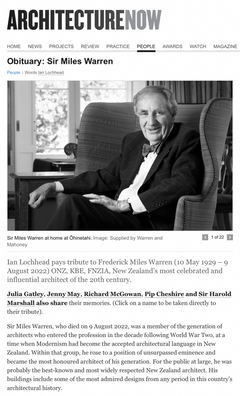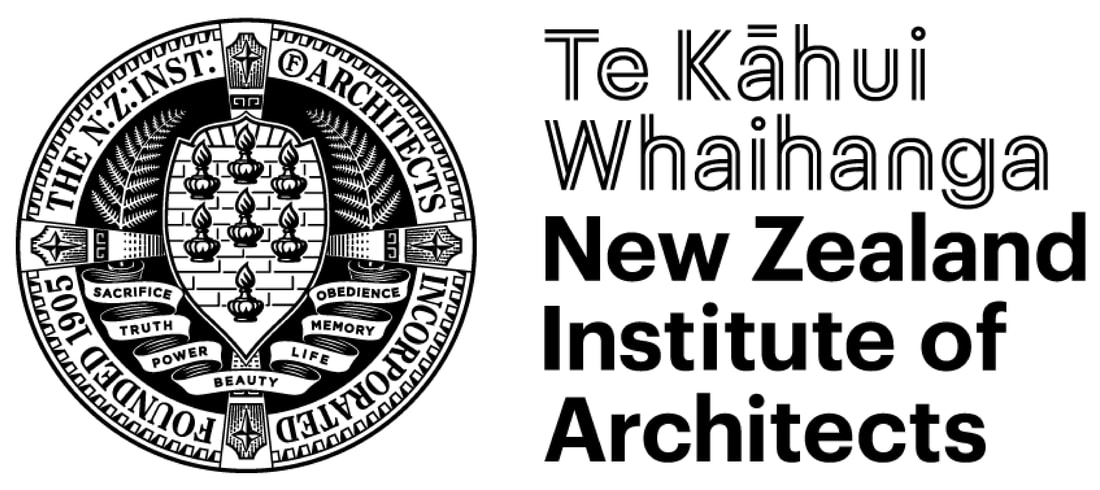
Ian Lochhead pays tribute to Frederick Miles Warren (10 May 1929 – 9 August 2022) ONZ, KBE, FNZIA, New Zealand’s most celebrated and influential architect of the 20th century.
Sir Miles Warren, who died on 9 August 2022, was a member of the generation of architects who entered the profession in the decade following World War Two, at a time when Modernism had become the accepted architectural language in New Zealand. Within that group, he rose to a position of unsurpassed eminence and became the most honoured architect of his generation. For the public at large, he was probably the best-known and most widely respected New Zealand architect. His buildings include some of the most admired designs from any period in this country’s architectural history.
Frederick Miles Warren was born in Christchurch on 10 May 1929. He was educated at Christ’s College, Christchurch, where he was strongly influenced by an architectural environment that dated back to the 1860s. He was academically gifted but his choice of architecture as a career was seen as regrettable; “Oh, Warren minor, we had high hopes for you”, was the crushing verdict of his headmaster. The two years he spent in the Christchurch office of Cecil Wood, from 1946 to 1947, were formative and his admiration for Wood was life long. Wood’s skill as a draftsman, his sensitivity to materials and his respect for tradition were important influences. Warren excelled as a student at Auckland University College School of Architecture in 1949 and 1950. Travelling to the United Kingdom, he found employment in the Housing Division of the London County Council. Under the leadership of Colin Lucas, the Housing Division was at the cutting edge of British architecture and Warren was able to absorb the lessons of post-war New Brutalism at its source while working on the designs for the Roehampton Estate (1953–1954). Travel in Europe further broadened his architectural horizons.Warren returned to Christchurch in 1955 and entered private practice. A brief partnership with G.T. Lucas was followed by one formed with Maurice Mahoney in 1958. Warren described their roles as being like two sides of the same coin; the design flair and outgoing personality of Warren was the perfect foil for Mahoney’s quiet demeanour and meticulous attention to detail. Their partnership, one of the most enduring and successful in New Zealand architecture, evolved into the company structure of Warren and Mahoney Architects Ltd, in 1985. Mahoney retired from the firm in 1992 followed by Warren in 1995. By this time, Warren and Mahoney had become a national architectural practice with offices in Auckland, Wellington and Queenstown, in addition to Christchurch. The professionalism and efficient management of the studio at 65 Cambridge Terrace made it a prized training ground for young architects and many went on to establish their own illustrious careers; Sir Ian Athfield was prominent among them.
Warren gained early recognition with his design for the Dorset Street Flats (1956–1957), in which New Brutalist principles were reinterpreted using white-painted concrete block with fair-faced concrete lintels. As Peter Beaven observed in 1967, “their statement of private urban living and their frank use of materials… was a revelation”. Their example helped spark the period of creativity in local architecture known as the Christchurch School. Over the next decade, Warren developed the ideas first seen at Dorset Street Flats in an impressive series of houses in which direct expression of materials, lucid planning and an underlying respect for tradition became the hallmarks of his early style. The Warren and Mahoney Office at 65 Cambridge Terrace (1962), with its dramatic roof-scape of broken gables, was effectively a constructed manifesto for the practice. Chapman Block (1961), a bold Brutalist statement within the Gothic Revival precinct of Christ’s College, cemented his long-standing architectural relationship with his old school.
At College House (1967), a residential hall at the University of Canterbury, a chapel and residential blocks flank a quadrangle, enclosed by a refectory at one end and a library at the other. While Warren’s modernist vocabulary remains paramount, his acknowledgement of the traditional collegiate typology adds resonance and gravitas to the design. Warren attributed the partnership’s success in the Christchurch Town Hall competition to the fact that it came at exactly the right time for them to capitalise on their accumulated experience. That building’s expressive forms and cross-axial plan, the sense of austere luxury resulting from meticulous details and quality finishes, along with the main auditorium’s feeling of intimacy, set a new standard for public architecture in New Zealand. The architects’ close collaboration with acoustic consultant Harold Marshall resulted in a concert hall that combined clarity of sound with resonance; it is internationally recognised as a milestone in concert hall design. From its completion in 1972, the building was embraced by the local community and, following the 2011 Canterbury earthquakes, a vigorous public campaign ensured its survival.
Warren was, by now, a national figure and, in 1985, he became the first New Zealand architect to receive a knighthood. The design for the New Zealand High Commission in Washington, DC (1979) demonstrated his ability to respond to a historic context, in this case Lutyens’ neoclassical British Embassy. His New Zealand High Commission, New Delhi (1990), pays a more overt tribute to Lutyens’ classicism. The Christ’s College Administration building (1988), added to the northern end of Wood’s Memorial Dining Hall, also pays homage to Warren’s early mentor.
Throughout his career, Warren was a vigorous advocate for architecture. Architectural education was a particular interest and he regularly welcomed students of architecture and architectural history to 65 Cambridge Terrace and, later, to Ōhinetahi, the historic house and garden that increasingly became his focus from 1995. He was, however, horrified when students failed to recognise the pantheon of architects’ names inscribed on the frieze above the bookshelves in his well-stocked library. In 2006, he established The Warren Trust to support architectural education; its assistance for a wide range of events and publications has made a significant contribution to our wider architectural culture. He also recognised the value of architectural records and the Warren and Mahoney partnership collection now resides in the Macmillan Brown Library at the University of Canterbury. It includes fine examples of Warren’s deft watercolour perspectives, a persuasive tool that allowed clients to visualise themselves in as-yet-unbuilt designs. Drawing was always central to Warren’s practice and he valued it, not just as a medium for transmitting ideas but also as a tool for understanding the world around him.
As is the case with other Canterbury architects, Warren’s built legacy suffered as a result of the earthquakes of 2010 and 2011. Few of Warren and Mahoney’s elegant Christchurch office buildings from the 1960s and ’70s remain but others, including the Dorset Street Flats, 65 Cambridge Terrace and the Town Hall have been meticulously repaired, strengthened and conserved. Dorset Street Flats, College House and the Town Hall, are now listed as Category 1 historic places by Heritage New Zealand, a distinction Warren regarded with wry amusement. In his view, buildings, his own included, needed to change and adapt over time if they were to continue in use. He was a generous supporter of heritage causes and played a key role in ensuring the survival of Christchurch’s Theatre Royal. In Wellington, Warren presided over the seismic strengthening and refurbishment of Parliament Buildings, at that time the country’s largest-ever heritage project.
Miles Warren was a gifted raconteur and his autobiography, published in 2008, captures his distinctive voice and sense of humour while providing a unique perspective on his distinguished career. Much of his success he put down to the good luck of being in the right place at the right time but, clearly, he also made his own luck. Fittingly, since Christ’s College remained a constant throughout his career, his funeral was held in the College Chapel on 18 August. He leaves us just as his garden at Ōhinetahi is about to burst into renewed life; house, garden and art collection were gifted to the people of New Zealand in 2012. These, The Warren Trust and the buildings produced during a lifetime of exceptional creativity remain as Sir Miles Warren’s remarkable legacy.
https://architecturenow.co.nz/articles/obituary-sir-miles-warren-1929-2022/



 RSS Feed
RSS Feed